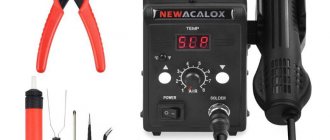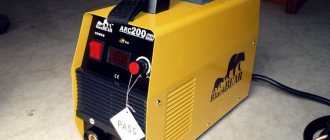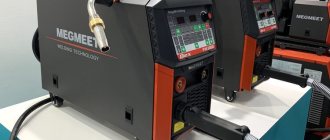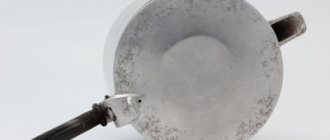A semiconductor device that has 5 pn junctions and is capable of passing current in the forward and reverse directions is called a triac. Due to the inability to operate at high frequencies of alternating current, high sensitivity to electromagnetic interference and significant heat generation when switching large loads, they are currently not widely used in high-power industrial installations.
Today, triac circuits can be found in many household appliances from hair dryers to vacuum cleaners, hand-held power tools and electric heating devices - where smooth power adjustment is required.
Do it yourself
Today, the range of triac regulators on sale is not very large. And, although the prices for such devices are low, they often do not meet consumer requirements. For this reason, we will consider several basic circuits of regulators, their purpose and the element base used.
Device diagram
The simplest version of the circuit, designed to work with any load. Traditional electronic components are used, the control principle is phase-pulse.
Main components:
- triac VD4, 10 A, 400 V;
- dinistor VD3, opening threshold 32 V;
- potentiometer R2.
The current flowing through potentiometer R2 and resistance R3 charges capacitor C1 with each half-wave. When the voltage on the capacitor plates reaches 32 V, the dinistor VD3 opens and C1 begins to discharge through R4 and VD3 to the control terminal of the triac VD4, which opens to allow current to flow to the load.
The opening duration is regulated by selecting the threshold voltage VD3 (constant value) and resistance R2. The power in the load is directly proportional to the resistance value of potentiometer R2.
An additional circuit of diodes VD1 and VD2 and resistance R1 is optional and serves to ensure smooth and accurate adjustment of the output power. The current flowing through VD3 is limited by resistor R4. This achieves the pulse duration required to open VD4. Fuse Pr.1 protects the circuit from short circuit currents.
Triacs should be selected according to the load size, based on the calculation of 1 A = 200 W.
Elements used:
- Dinistor DB3;
- Triac TS106-10-4, VT136-600 or others, the required current rating is 4-12A.
- Diodes VD1, VD2 type 1N4007;
- Resistances R1100 kOhm, R3 1 kOhm, R4 270 Ohm, R5 1.6 kOhm, potentiometer R2 100 kOhm;
- Capacitor C1 0.47 µF (operating voltage from 250 V).
Note that the scheme is the most common, with minor variations. For example, a dinistor can be replaced with a diode bridge, or an interference-suppressing RC circuit can be installed in parallel with the triac.
A more modern circuit is one that controls the triac from a microcontroller - PIC, AVR or others. This circuit provides more accurate regulation of voltage and current in the load circuit, but is also more complex to implement.
Triac power regulator circuit
Assembly
The power regulator must be assembled in the following sequence:
- Determine the parameters of the device on which the device being developed will work. Parameters include: number of phases (1 or 3), the need for precise adjustment of output power, input voltage in volts and rated current in amperes.
- Select the type of device (analog or digital), select elements according to load power. You can check your solution in one of the programs for modeling electrical circuits - Electronics Workbench, CircuitMaker or their online analogues EasyEDA, CircuitSims or any other of your choice.
- Calculate the heat dissipation using the following formula: voltage drop across the triac (about 2 V) multiplied by the rated current in amperes. The exact values of the voltage drop in the open state and the rated current flow are indicated in the characteristics of the triac. We get the power dissipation in watts. Select a radiator according to the calculated power.
- Purchase the necessary electronic components , heatsink and printed circuit board.
- Lay out contact tracks on the board and prepare sites for installing elements. Provide mounting on the board for a triac and radiator.
- Install the elements on the board using soldering. If it is not possible to prepare a printed circuit board, then you can use surface mounting to connect the components using short wires. When assembling, pay special attention to the polarity of connecting the diodes and triac. If there are no pin markings on them, then test them using a digital multimeter or a “dragstick”.
- Check the assembled circuit with a multimeter in resistance mode. The resulting product must correspond to the original design.
- Securely attach the triac to the radiator. Don’t forget to lay an insulating heat transfer gasket between the triac and the radiator. The fastening screw is securely insulated.
- Place the assembled circuit in a plastic case.
- Remember that there is dangerous voltage at the terminals of the elements.
- Turn the potentiometer to minimum and perform a test run. Measure the voltage at the regulator output with a multimeter. Smoothly turn the potentiometer knob to monitor the change in output voltage.
- If the result is satisfactory, then you can connect the load to the output of the regulator. Otherwise, it is necessary to make power adjustments.
Read also: Voltage regulator on dinistor
Triac power radiator
Power adjustment
The power control is controlled by a potentiometer, through which the capacitor and the capacitor discharge circuit are charged. If the output power parameters are unsatisfactory, you should select the resistance value in the discharge circuit and, if the power adjustment range is small, the potentiometer value.
In almost any radio-electronic device, in most cases there is power adjustment. You don’t have to look far for examples: these are electric stoves, boilers, soldering stations, various motor rotation controllers in devices.
The Internet is full of ways to assemble a 220 V voltage regulator with your own hands. In most cases, these are circuits based on triacs or thyristors. The thyristor, unlike the triac, is a more common radio element, and circuits based on it are much more common. Let's look at different design options based on both semiconductor elements.
Smooth start of a power tool in a carrier
Do it yourself
Some power tools, due to their functional features, do not have a built-in speed controller. In this article, we will modify the extension cord so that the power tool connected to it starts smoothly.
What is it for?
If the tool is not equipped with a speed controller, then it does not need one. An angle grinder, for example, is always used at full speed, otherwise it becomes dangerous. Why does such a power tool need a soft start? There are many reasons, because a sharp start of the engine of the same grinder or electric jointer causes:
- burnout of brushes and rotor lamellas;
- electric shock in the electrical network;
- an attempt of the instrument to escape from the hands, which is unsafe;
- strong starting impact of the gears of the gearbox against each other, causing their rapid wear.
With a smooth start, neither current nor mechanical shock will occur. The power tool engine will start smoothly and reach maximum speed.
Choosing a scheme
There are many soft start schemes, we will try to choose something suitable and most affordable for us.
On discrete elements
The regulator, the diagram of which is presented below, is assembled on a symmetrical thyristor (triac) KU208G and allows for smooth start-up of power tools with a power of up to 2 kW.
Immediately after applying voltage to the circuit (toggle switch SA1), capacitor C1 is discharged, triac VS1 is closed and motor M does not rotate. Next, the capacitor is gradually charged through the diode VD1 and resistor R2, the triac begins to open, but with a long delay from the beginning of the half-wave of the mains voltage. A small initial voltage is applied to the motor and it starts at minimum speed.
As the capacitor charges, the opening delay of the triac decreases, the voltage on the motor increases, and therefore the speed increases. As soon as the capacitor is fully charged, the symmetrical thyristor will open at the beginning of each half-wave, supplying full mains voltage to the motor, and the latter will reach full speed.
The soft start time can be adjusted by selecting the capacitance of capacitor C1. At the indicated ratings (500 µF), the instrument will return to operating mode approximately 2-3 seconds after switching on.
Important! When the power of the power tool is more than 500 W, a symmetrical thyristor must be installed on the radiator.
On a microcircuit and triac
This circuit is assembled on the domestic universal microcircuit KR1182PM1. With its help, you can build both a soft starter and a voltage regulator. In the diagram below, the microcircuit is turned on in soft start mode.
Since the microcircuit has a relatively low output power - up to 150 W - it is equipped with a powerful output switch, which is a symmetrical thyristor TS122-20-10, which can withstand current up to 20 A. The time it takes for the engine to reach operating mode depends on the capacitance of capacitor C1. Such a circuit can operate without a radiator at a load power of up to 1 kW.
Healthy! If necessary, the TS122-20-10 triac can be replaced with a KU208G, but the power of the device with such a replacement will drop by half.
Integral regulator
The circuit based on discrete elements is quite simple and does not contain scarce elements, but it is too bulky and will have to be placed in a separate case, especially if the power tool is powerful and a radiator is required. In this regard, it is much more convenient to use ready-made integrated soft start units. The most convenient option for us is KRRQD20A.
The compact integrated soft start unit (SPU) is designed for current up to 20 A and is capable of switching power up to 4 kW. The module has 2 outputs and is connected to a break in one of the power wires of the tool motor. If you equip an extension cord with it (for some reason many people call it a carrier), then the power tool connected through it will start smoothly when you press the power button.
The photo clearly shows that the module is designed for installation on a radiator, but if the power of the power tool does not exceed 1 kW, then a radiator is not required.
Important! There are similar modules with the same functions, but with three outputs. For our purposes, they are not suitable, since they are not simply connected to a break in the supply wire, but supply voltage to the motor via a separate line.
The connection diagram is printed directly on the body of the device and it is obvious that it can only be used by installing it after the switch in the power tool itself. This is also a good option, but, firstly, the extension cord is a more universal solution (you can connect any tool or even a lamp), and, secondly, by disassembling the tool, we lose warranty service.
Triac power regulator
A triac, by and large , is a special case of a thyristor that passes current in both directions, provided that it is higher than the holding current. One of its disadvantages is its poor performance at high frequencies. Therefore, it is often used in low-frequency networks. It is quite suitable for building a power regulator based on a regular 220 V, 50 Hz network.
The voltage regulator on the triac is used in ordinary household appliances where adjustment is needed. The power regulator circuit on a triac looks like this.
- Etc. 1 – fuse (selected depending on the required power).
- R3 – current-limiting resistor – serves to ensure that when the potentiometer resistance is zero, the remaining elements do not burn out.
- R2 is a potentiometer, a trimming resistor, which is used for adjustment.
- C1 is the main capacitor, the charge of which unlocks the dinistor to a certain level; together with R2 and R3 it forms an RC circuit
- VD3 is a dinistor, the opening of which controls the triac.
- VD4 – triac – the main element that performs switching and, accordingly, adjustment.
The main work is assigned to the dinistor and triac. The mains voltage is supplied to an RC circuit in which a potentiometer is installed, which ultimately regulates the power. By adjusting the resistance, we change the charging time of the capacitor and thereby the threshold for turning on the dinistor, which, in turn, turns on the triac. An RC damper circuit connected in parallel with the triac serves to smooth out noise at the output, and also protects the triac from surges of high reverse voltage in case of a reactive load (motor or inductance).
The triac turns on when the current passing through the dynistor exceeds the holding current (reference parameter). It turns off, respectively, when the current becomes less than the holding current . Conductivity in both directions allows for smoother adjustment than is possible, for example, with a single thyristor, while using a minimum of elements.
The power adjustment oscillogram is shown below. It shows that after the triac is turned on, the remaining half-wave is supplied to the load and when it reaches 0, when the holding current decreases to such an extent that the triac turns off. In the second “negative” half-cycle, the same process occurs, since the triac has conductivity in both directions.
User voting
Which power regulator would you choose or recommend?
Wenfu GT10000W-SL
0.00% ( 0 )
YXD Wish 10000W
0.00% ( 0 )
Wenfu ST-BTA41
0.00% ( 0 )
Wenfu GT10000W
14.29% ( 1 )
SNDY SNT4000W
0.00% ( 0 )
CHMAWAY 4000W
0.00% ( 0 )
YXD Wish X4CN
28.57% ( 2 )
RQG 4000W
14.29% ( 1 )
YXD Wish ACMC100-1
0.00% ( 0 )
SHENGKU VR-AC220V
14.29% ( 1 )
Akin W205
0.00% ( 0 )
Goodland DC12-24V
0.00% ( 0 )
Foocle FLS820
14.29% ( 1 )
Vyeofar VF30A-RF
0.00% ( 0 )
HWAYEH DC10-60V
14.29% ( 1 )
Luyu LV-2.4G-4054
0.00% ( 0 )
Thyristor voltage
First, let's figure out how a thyristor differs from a triac. A thyristor contains 3 pn junctions, and a triac contains 5 pn junctions. Without going into details, in simple terms, a triac conducts in both directions, while a thyristor conducts only in one. Graphic designations of the elements are shown in the figure. This is clearly visible from the graphics .
The operating principle is absolutely the same. This is what power regulation is based on in any circuit. Let's look at several thyristor-based regulator circuits. The first is the simplest circuit, which basically repeats the triac circuit described above. The second and third are using logic, circuits that better dampen the interference created in the network by switching thyristors.
Simple scheme
A simple phase control circuit on a thyristor is presented below.
Its only difference from the triac circuit is that only the positive half-wave of the mains voltage is adjusted. The timing RC circuit, by adjusting the resistance value of the potentiometer, regulates the trigger value, thereby setting the output power supplied to the load. On the oscillogram it looks like this.
From the oscillogram it can be seen that power regulation occurs by limiting the voltage supplied to the load. Figuratively speaking, the regulation consists of limiting the flow of mains voltage to the output. By adjusting the charging time of the capacitor by changing the variable resistance (potentiometer). The higher the resistance, the longer it takes to charge the capacitor and the less power will be transferred to the load. The physics of the process is described in detail in the previous diagram. In this case, it is no different.
With logic based generator
The second option is more complicated. Due to the fact that switching processes on thyristors cause great noise in the network, this has a bad effect on elements installed on the load. Especially if the load is a complex device with fine settings and a large number of microcircuits.
Read also: Do-it-yourself machine for sharpening cutters
This DIY implementation of a thyristor power regulator is suitable for active loads, for example, a soldering iron or any heating devices. There is a rectifier bridge at the input, so both waves of the mains voltage will be positive. Please note that with such a circuit, an additional +9 V DC voltage source will be needed to power the microcircuits. Due to the presence of a rectifier bridge, the oscillogram will look like this.
Both half-waves will now be positive due to the influence of the rectifier bridge. If for reactive loads (motors and other inductive loads) the presence of oppositely polar signals is preferable, then for active ones a positive power value is extremely important. The thyristor also turns off when the half-wave approaches zero, the holding current is supplied to a certain value and the thyristor is turned off.
Based on transistor KT117
The presence of an additional constant voltage source can cause difficulties; if it is not there, you will have to install an additional circuit. If you do not have an additional source, then you can use the following circuit, in which the signal generator to the control output of the thyristor is assembled using a conventional transistor. There are circuits based on generators built on complementary pairs, but they are more complex, and we will not consider them here.
In this circuit, the generator is built on a dual-base transistor KT117, which, when used in this way, will generate control pulses with a frequency set by trimming resistor R6. The diagram also includes an indication system based on the HL1 LED.
- VD1-VD4 is a diode bridge that rectifies both half-waves and allows for smoother power adjustment.
- EL1 - incandescent lamp - is represented as a load, but it can be any other device.
- FU1 is a fuse, in this case it is 10 A.
- R3, R4 - current-limiting resistors - are needed so as not to burn the control circuit.
- VD5, VD6 – zener diodes – perform the role of stabilizing the voltage at a certain level at the emitter of the transistor.
- VT1 - transistor KT117 - must be installed with exactly this location of base No. 1 and base No. 2, otherwise the circuit will not work.
- R6 is a tuning resistor that determines the moment when a pulse arrives at the control output of the thyristor.
- VS1 – thyristor – element that provides switching.
- C2 is a timing capacitor that determines the period of appearance of the control signal.
The remaining elements play a minor role and mainly serve to limit current and smooth out pulses. HL1 provides an indication and signals only that the device is connected to the network and is energized.
Power regulators are widely used in everyday life. Their use is very diverse: from regulating the brightness of lighting to controlling the speed of various engines, they can be used to set the required temperature of various heating devices. Thus, power can be adjusted for any type of load, both reactive and active.
A power regulator is a specific electronic circuit with which you can control the amount of energy supplied to the load.
Types and characteristics of regulators
Devices designed to control power values are divided according to the adjustment method:
- thyristor;
- triac;
- phase (dimmer).
By type of output signal:
- stabilized;
- not stabilized.
Adjustment is carried out when powered by both direct and alternating voltage. You can control the voltage or current.
Depending on their location, regulators can be portable or stationary, installed in any position: vertical, ceiling, horizontal, mounted on a special DIN rail or built-in. Structurally, they are carried out both on specialized printed circuit boards and using surface-mounted installation.
The main characteristics that you should pay attention to are the following parameters:
- smooth adjustment;
- operating and peak power input;
- input operating voltage range;
- voltage setting range supplied to the load;
- terms of Use.
Specifications
In order not to make a mistake in choosing a thyristor, you must first pay attention to the maximum permissible performance characteristics. If at least one of the parameters exceeds these values, the device will fail. All data required for circuit calculations is given in the table.
In addition to the maximum permissible parameters, there are also electrical parameters that show what a given device is capable of. All these parameters are tested by the manufacturer at a standard ambient temperature of + 25°C.
Thyristor power regulator
The circuit and operating principle of such a device are not particularly complicated. The main purpose of a thyristor converter is to control devices with low power, but in rare cases, high power. The operation is based on the use of a delay in switching on a thyristor switch during a half-cycle of alternating current. The main component of such a circuit is a thyristor operating in switch mode. When a potential difference appears at the control contact, it opens. The longer the turn-on delay, the less power is supplied to the load.
The simplest circuit, in addition to the thyristor, contains two bipolar transistors, two resistors that set the operating point, and a capacitor. Transistors, operating in switch mode, generate a control signal. As soon as the potential difference across the capacitor reaches a value equal to the operating value, the transistors open and a signal is sent to the control contact. The capacitor begins to discharge until the next half cycle.
The advantages of this type of regulator are that it does not require adjustment, but the disadvantage is that it generates excessive heat . To combat overheating, both active and passive cooling systems are used.
A thyristor regulator is used to control the power of household (soldering irons, electric heaters, incandescent lamps) and industrial devices (soft start of powerful power plants). The unit can be single-phase or three-phase.
Read also: Carrot for wood splitter drawing
Making the device yourself
If there is a need to use a thyristor power regulator, you can make a device of good quality with your own hands. To do this, you need to purchase a kit at a specialized point of sale that contains a detailed diagram describing the principle of assembly and operation. Or you can use any circuit from the Internet or literature and solder the device yourself.
Any type can be used as thyristors, for example, domestic KU202N or imported bt151, depending on the required power. In addition to the thyristor, the value of the latter will also depend on the parameters of the diode bridge used in the circuit. Power adjustment is carried out using a variable resistor. If there is no possibility or desire to make a printed circuit board, you can assemble the device using surface mounting. In this case, it is necessary to carefully insulate all connections to avoid short circuits.
Triac power regulator
A triac is a semiconductor element intended for use in alternating current circuits. A distinctive feature of the device is that its terminals are not divided into anode and cathode. Unlike a thyristor, which conducts current in only one direction, a triac conducts current in both directions. It is precisely because of this ability that the triac is used in AC networks.
Power is regulated in this case by changing the number of voltage half-cycles that act on the load. The main difference from thyristor circuits is that a rectifier device is not used here. The operation of the circuit is based on the principle of phase control, that is, on changing the opening moment of the triac relative to the transition of the mains voltage through zero.
This device is used to control heating elements, incandescent lamps, and engine speed. The output signal of the device has a sawtooth shape with a controlled pulse duration.
Making the device yourself is even easier than making a thyristor regulator. Medium power triacs such as BT137−600E or MAC97A6 have become widely popular. The power regulator circuit using a triac using these elements is easy to manufacture.
Precious metal content
As with many other radio components, certain types of triacs use precious metals during production. As for the KU208G under consideration, information on the content of valuable substances varies in different sources. One thing is certain - this thyristor contains gold. Here is a fragment of the product label, which indicates that 1000 pcs. contains 1.4765 g of noble metal. It turns out that 0.001477g can be extracted from one.
Phase regulator
Phase control is used to smoothly start various types of motors or control current when charging a battery. One type of such device is a dimmer.
The basis of the work lies in changing the opening angle of the key thyristor, as a result of which the load receives signals with the initial part of the half-cycle cut off, and the effective voltage value is reduced.
The advantage of this type of regulation is its low cost due to the use of inexpensive radio components. But the main disadvantage is a significant ripple factor and low power factor of the output signal.
Often, low-frequency microcircuits are used in the design of this type of regulator. Thanks to this, the regulator is able to quickly change power. Phase regulators are rarely stabilized using zener diodes; usually the role of a stabilizer is performed by thyristors operating in pairs.
DIY power regulator for a soldering iron
Let's look at an example of making a current regulator with your own hands. For example, we will regulate the power of a soldering iron. Regulation in such a device allows you to avoid overheating the soldering area and can protect the soldering iron tip from burnout.
This type of device has been produced for quite a long time. One of its types was a domestic device called “Additional device for electric soldering iron type P223.” It allowed the use of a low-voltage soldering iron with a voltage of 36 volts, powered from a 220 V network.
Triac regulator KU208G
The device circuit is quite interesting and easy to implement. Its distinctive feature is the use of a neon light bulb.
The capacitor, about 0.1 μF, is designed to generate a sawtooth pulse and protect the control circuit from interference. Resistors are used to limit the current, and with the help of a variable resistor the current is regulated, its value is about 220 kOhm. The neon light allows linear control and is also an indicator. You can control the adjustment based on the intensity of its brightness.
The disadvantage of such a scheme will be poor awareness of the power of the soldering iron. To visually display the values of the set value, with a sufficient level of radio training, you can use a microcontroller, for example, pic16f628a. It will also be possible to perform electronic power control on it, eliminating the need for a variable resistor.
Adjustment on the integral stabilizer
Another way to control power is to use integrated stabilizers. Using such a device, it is very easy to make a dimmer for a 12 volt voltage regulator. This device is easy to assemble and has built-in protection; it can be used both to connect a 12 V soldering iron and an LED strip. Typically, a variable resistor is connected to the input of the control electrode of the microcircuit. The disadvantage is the strong heating of the stabilizing chip.
The alternating voltage of the 220 V network is reduced through a transformer to 16-18 volts. Then, through a diode bridge and a smoothing capacitor, the rectified value is supplied to the input of the linear stabilizer. Using a variable resistor, by changing the operating characteristics of the microcircuit, the required output voltage is set. This voltage will be stabilized and in our case will be 12 volts.
When making devices yourself, be careful and remember about safety precautions when working with a 220 V AC network. As a rule, a correctly made regulator made from serviceable parts does not require adjustment and immediately starts working.











